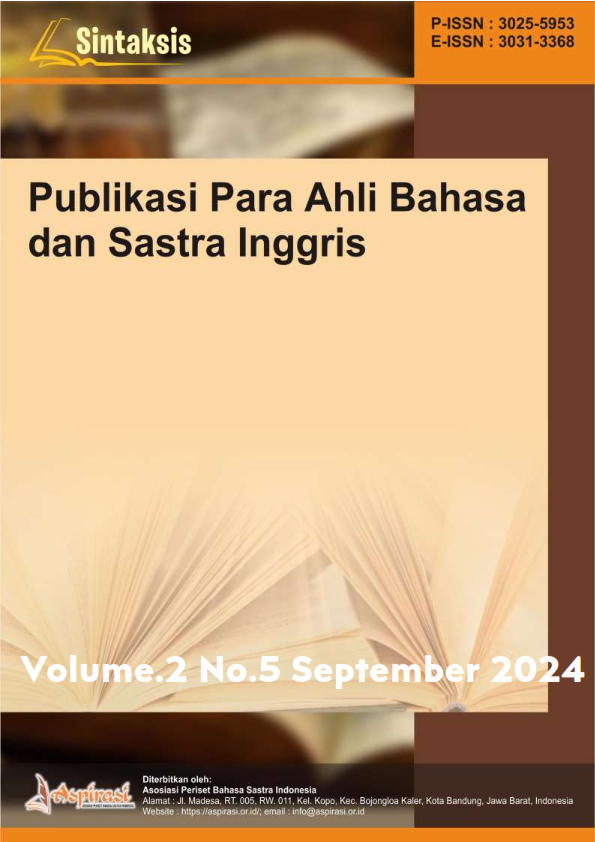Teacher Talk Analysis in The Youtube Video "Differentiated Learning on Self-Introduction" From SMAN 1 Pangkalan Susu Through FIAC
DOI:
https://doi.org/10.61132/sintaksis.v2i5.1090Keywords:
Teacher Talk, Flanders Interaction Analysis Category (FIAC), Classroom Interaction, Differentiated Learning, Student EngagementAbstract
This study analyzes teacher talk in the YouTube video "Differentiated Learning on Self-Introduction" from SMAN 1 Pangkalan Susu using the Flanders Interaction Analysis Category (FIAC) system. Teacher talk, which includes both direct and indirect verbal interactions, plays a critical role in fostering an engaging and effective learning environment. The research focuses on identifying patterns of teacher-student interactions that support differentiated learning, a method designed to cater to individual student needs. The results reveal that indirect talk, such as accepting feelings and giving encouragement, accounts for 60.87% of the interactions, while direct talk, like giving instructions and lecturing, constitutes 39.13%. This balance suggests a strong emphasis on student engagement through supportive communication, essential for differentiated learning environments.
Downloads
References
Baker, R. S., & Inventado, P. S. (2020). Educational data mining and learning analytics. Journal of Educational Technology & Society, 23(1), 1-15.
Chuntala, S. (2019). Observing classroom interactions: A methodological approach. Journal of Language and Education, 5(1), 45-54.
Dagarin, M. (2004). Classroom interaction and communication strategies. ELT Journal, 58(3), 241-250.
Dagarin, M. (2004). Teacher talk and student talk in the classroom. Educational Studies, 30(3), 267-284.
Davis, M. H., & Houghton, S. (2021). Emotional intelligence in the classroom: A review of the literature. Educational Psychology Review, 33(3), 789-812.
Fithriani, F. (2021). The role of effective communication in enhancing student learning. Journal of Educational Psychology, 113(2), 245-260.
Fithriani, R. (2021). Code-switching as an EFL instructional strategy: An insight to Indonesian lecturers’ practices. Language Literacy: Journal of Linguistics.
Flanders, N. A. (1970). Analyzing teacher behavior. Addison-Wesley.
Flanders, N. A. (1970). Analyzing teacher-student interaction. Educational Leadership, 28(1), 24-29.
Flanders, N. A. (1970). Analyzing teacher-student interaction. In The Flanders Interaction Analysis Categories (FIAC) System.
Gibbons, P. (2002). Scaffolding language, scaffolding learning: Teaching second language learners in the mainstream classroom. Portsmouth, NH: Heinemann.
Gordon, T. (2020). The impact of teacher-student relationships on student engagement. International Journal of Educational Research, 102, 101-110.
Harmer, J. (2007). The practice of English language teaching. Pearson Longman.
Hattie, J., & Timperley, H. (2019). The power of feedback. Review of Educational Research, 77(1), 81-112.
Kumar, R., & Sharma, A. (2022). Differentiated instruction: A strategy for improving student learning. Journal of Curriculum Studies, 54(4), 487-505.
Levy, R., & Murnane, R. J. (2022). The role of technology in differentiated instruction. Computers & Education, 178, 104-120.
McLaughlin, M. W., et al. (2012). Qualitative research in education: A user's guide. SAGE Publications.
McTighe, J., & Wiggins, G. (2005). Understanding by design. Alexandria, VA: ASCD.
Mercer, N. (2000). Words and minds: How we use language to think together. Routledge.
Richards, J. C., & Rodgers, T. S. (2001). Approaches and methods in language teaching. Cambridge: Cambridge University Press.
Smith, J. K., & Brown, T. (2023). Collaborative learning and its impact on student outcomes. Journal of Educational Research, 116(1), 45-60.
Tomlinson, C. A. (2001). How to differentiate instruction in mixed-ability classrooms. Alexandria, VA: ASCD.
Tomlinson, C. A. (2020). How to differentiate instruction in academically diverse classrooms. ASCD.
Ur, P. (1996). A course in language teaching: Practice and theory. Cambridge University Press.
Vygotsky, L. S. (1978). Mind in society: The development of higher psychological processes. Cambridge, MA: Harvard University Press.
Zhang, Y., & Wang, L. (2021). The effects of teacher feedback on student performance: A meta-analysis. Educational Psychology Review, 33(2), 345-367.
Downloads
Published
How to Cite
Issue
Section
License
Copyright (c) 2024 Sintaksis : Publikasi Para ahli Bahasa dan Sastra Inggris

This work is licensed under a Creative Commons Attribution-ShareAlike 4.0 International License.





